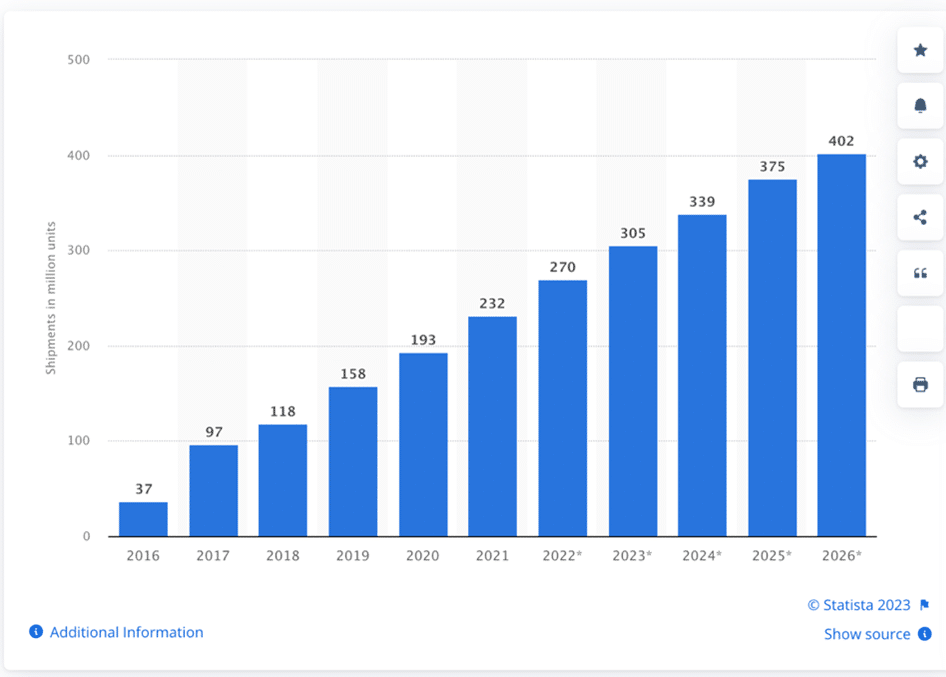[ad_1]
What do teen peer stress, wearable gross sales traits, and hybrid work should do with SMBs and value-added providers for Group & Voluntary advantages? Nicely, let’s discover out.
Teen peer stress provides Apple a brand new platform for rising wearable use in Gen Z.
Presently, 87% of Gen Z teenagers who personal a smartphone, personal an iPhone, versus an Android or different smartphone.[i] Apple opponents blame peer stress for the regular development (a significant bone of rivalry is the inexperienced textual content bubble that iPhone customers obtain from non-Apple units). It doesn’t matter what the reason being, nonetheless, with almost 90% model penetration into an vital group, these iPhone purchases are ushering Gen Z teenagers into the world of Apple. From right here on, they proceed to purchase different Apple merchandise, such because the Apple Watch, and they’ll persistently make the most of Apple providers equivalent to ApplePay.
The Apple Watch is extra vital to the way forward for Group & Voluntary advantages than insurers might imagine. The reason being that wearables stand to affect total worker populations by being able to enhance well being and wellness outcomes. And, that is the important thing, total worker populations are part of the rising market of wearables. Wearables are getting extra widespread amongst a broad spectrum of sub-groups, together with:
- Extraordinarily-health-conscious folks who’re interested by all of their well being knowledge for coaching causes.
- On a regular basis customers who’re merely interested by maintaining a tally of their well being whereas pursuing reasonable well being targets.
- “Linked” expertise lovers who prefer to periodically untether from their telephones whereas staying tethered to their data (monetary, social, — not simply well being knowledge.)
- Individuals with persistent circumstances who want to watch a few of their numbers for medical functions.
Even when a Group or Voluntary advantages supplier doesn’t at present see a must make the most of wearables, wearable knowledge, or linked experiences, they need to severely start contemplating how and the place employers may profit from services that may be tied to wearables. Because the market grows, SMB expectations proceed to evolve as effectively. HR groups will probably be asking for linked services. It’s a pattern that’s too huge to disregard. Staff themselves will probably be searching for methods they’ll use their wearables to enhance their work and private lives.
Wearable gross sales traits are sturdy and never slowing down. SMBs must know that well being monitoring is on the rise.
Wearable development can even proceed to be on the rise amongst almost all ages group, not simply Gen Z. In truth, 34% of all shoppers already personal a smartwatch, but by 2026, wearable cargo traits will proceed to develop simply as quick as they’ve for the final 10 years. Which means that the marketplace for wearables isn’t exhibiting indicators of saturation.[ii] It’s solely exhibiting indicators of better adoption and integration.
Determine 1: Good wearable shipments worldwide from 2016-2026. Statista
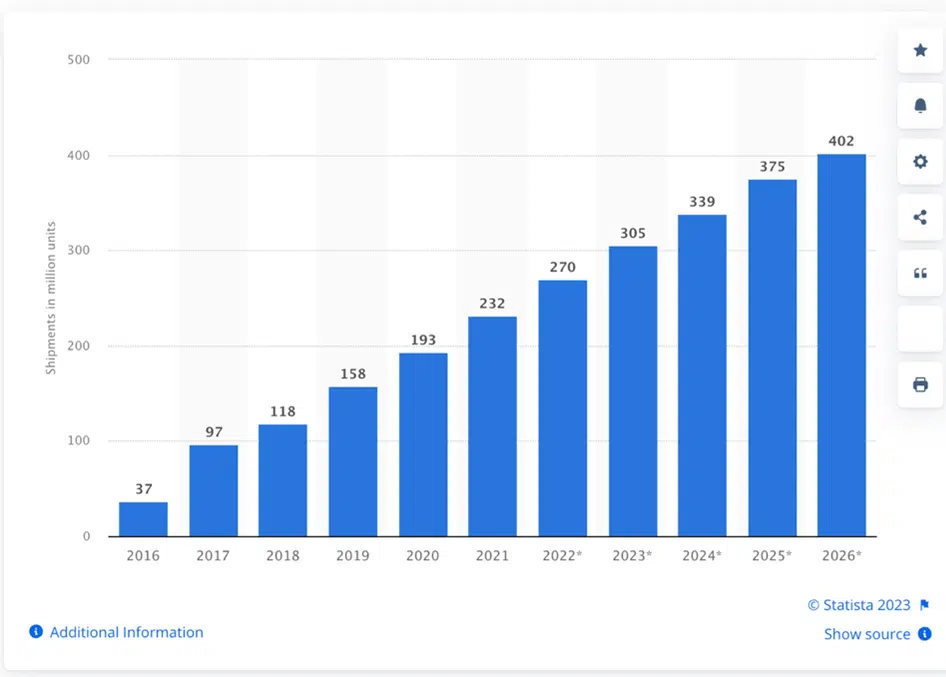
The result’s that, on the whole, worker populations are paying extra consideration to their well being and so they could also be getting more healthy. Pundits may say that the wearable market development doesn’t essentially predict wearable utilization for health-related functions, however well being apps are additionally in fast development mode. In 2022, well being apps introduced in $8.2 billion and by 2030, they’re predicted to herald $35.7 billion.[iii] For Group & Voluntary advantages suppliers, it is a golden alternative for growth — both creating wearable apps that hyperlink to new merchandise or value-added providers — or partnering with one of many many new well being apps to hyperlink app and knowledge utilization.
Determine 2: Whole Annual Income within the Well being App Business
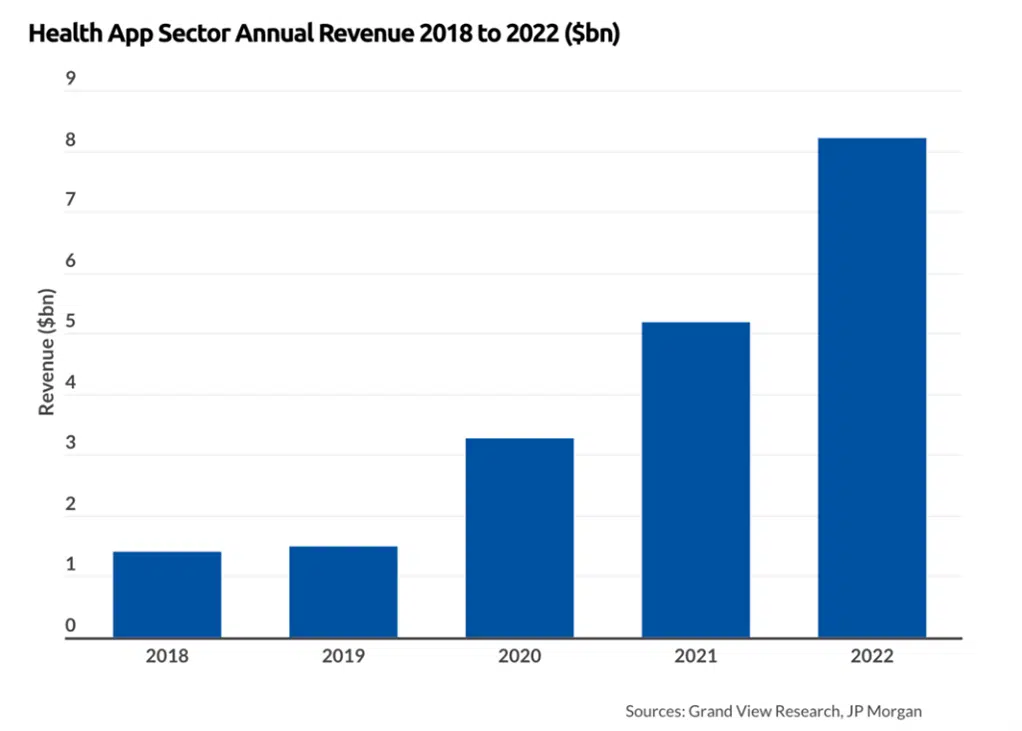
Hybrid workforce getting more healthy, commuting much less, and utilizing their time extra correctly.
Quickly after the pandemic, companies small and enormous started to contemplate the way forward for distant work. “What are we going to do about distant work? Is hybrid work going to assist us or harm us?” It didn’t take monetary groups lengthy to determine that hybrid and distant work may lower down on workspace bills, assist construct loyalty amongst staff, and even contribute to the rising expertise concern by permitting SMBs to rent for some roles exterior of their geography.
What they didn’t know was that hybrid and distant work may enhance worker well being. A current research by IWG decided that in a sampling of two,000 hybrid staff, hybrid staff are exercising extra (virtually 90 minutes extra per week on common). They’re commuting much less, which contributes to environmental targets and has “led to an additional 71 hours of sleep per 12 months.” And, almost 1 / 4 of hybrid staff have misplaced weight — 20 lbs. or extra. As well as, hybrid staff are consuming more healthy.[iv]
What’s the potential affect of those traits from a Group & Voluntary advantages perspective?
- Life, supplemental life, CI, most cancers, and hospital indemnity insurance policies may even see a gentle enchancment in claims ratios.
- Conventional well being plans may see a marked enchancment in SMB protection for SMBs who make the most of hybrid staff.
- Train could also be prepared for its personal sort of insurance coverage or value-added service merchandise that transcend voluntary accident insurance coverage.
- Reductions for wearable customers might enhance gross sales of these merchandise as wearable use rises.
- Hybrid and distant staff are driving much less. Group & Voluntary Auto/House insurance policies could possibly be created particularly for the no-commute/low-commute worker.
- Profit incentives could possibly be created for SMBs that select to make use of hybrid staff for a sure share of their workforce.
- Group & Voluntary advantages suppliers can now take a look at the entire realm of product and repair alternatives in a unique gentle than they’ve previously.
- Most Group & Voluntary core methods aren’t but ready to satisfy at present’s SMB alternatives.
Dozens or lots of of potential services will grow to be far more viable in gentle of those three traits. The true query is: are SMBs prepared for these new services proper now or will it take time for them to know the potential of recent choices? Majesco discovered the reply in our surveys of SMB decision-makers — was a convincing sure!
SMBs and Staff are Prepared for Extra Than Insurers Can Presently Present
Throughout the board, there’s a important buyer expectation hole between what clients need – no matter generational group – and what insurers are delivering, as represented in Determine 3. These value-added providers present tangible worth and improve total wellness with alerts and extra.
As well as, these choices may collect extra customized knowledge to boost their pricing in addition to their total expertise. Many are “low hanging fruit” that may not take lots of effort, however will create great worth and begin insurers down the street to a extra holistic, valued providing and expertise for patrons.
Determine 3: SMB-Insurer gaps in value-added providers for group/voluntary advantages
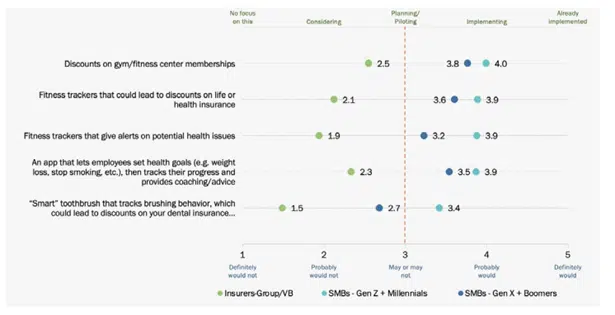
A key technique for insurers to deal with buyer expectations is to extend the worth of the merchandise they provide. To take action, insurers ought to bundle, or provide for a worth, value-added providers that reach the worth of the danger product/coverage, equivalent to incomes factors for wellness that can be utilized to purchase issues, annual monetary planning evaluation, roadside help, and extra.
Worth-added providers can create new income alternatives whereas additionally strengthening the shopper relationship, loyalty, belief, and worth.
As SMB corporations are rising their advantages choices for workers, it’s clear that they’re interested by holistic safety for his or her staff that may embody well being, wellness, monetary stability, social and emotional help, and all types of safety. When Majesco checked out what varieties of advantages SMBs had been providing, there was a pointy distinction between Gen Z/Millennials and Gen X/Boomers. (See Determine 4.) These variations spotlight the course of SMB advantages choices. To satisfy the wants of SMBs, insurers should put together, not only for new merchandise, however for totally new methods to absorb and handle knowledge.
Determine 4: Voluntary Advantages supplied
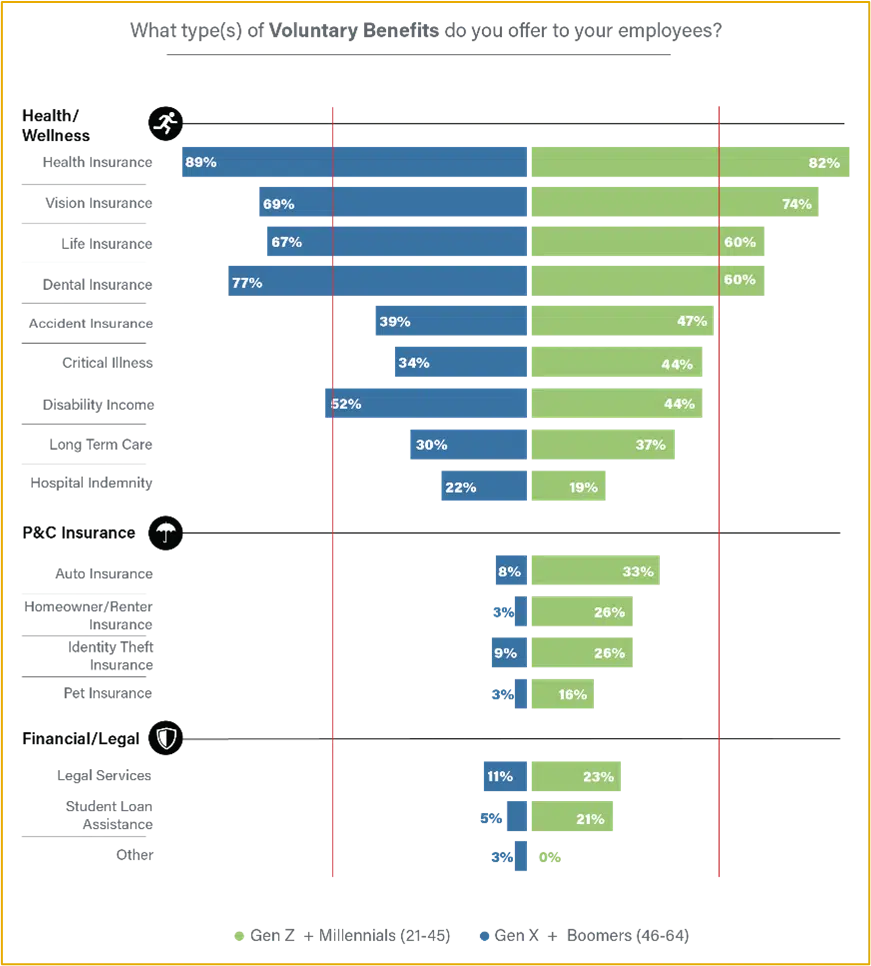
Innovating to Meet the SMB Market Calls for
The necessity for innovation round worker advantages and coverages for a youthful era who’ve completely different way of life wants and for an older era that need to port insurance coverage after retirement or may fit as an on-demand/Gig employee are collectively a dominant a part of the workforce. Progressive new plans and insurance coverage choices and portability are more and more vital to draw and retain staff in addition to preserve them as clients as they alter jobs.
Insurers should strike the proper stability when it comes to the product, value-added providers, and expertise to help the breadth of generations inside the workforce. With the emergence of a extra diversified office throughout all generations, staff, and subsequently, employers, count on a broader portfolio of group and voluntary advantages merchandise that may meet their private wants, life stage, and way of life. Whereas many employers proceed to supply the normal merchandise of well being, dental, imaginative and prescient, STD, LTD, and life, there may be an rising demand for brand new, revolutionary merchandise in addition to monetary wellness choices.
To retain and develop their enterprise, insurers should rethink their scope to a broader way of life expertise throughout well being, wealth, and wellness.
The alternatives are nonetheless rising, however capturing them requires applied sciences that aren’t at present utilized by most Group & Voluntary advantages suppliers — as a result of most are on decades-old legacy methods! Sure legacy methods will not be a roadblock to the longer term.
Majesco has created core options for group and voluntary advantages and value-added providers that won’t solely deliver insurers into the digital age however can even put together to offer the info and analytic suggestions insurers and employers must optimize their choices. That is essential! With out the flexibility to adequately deal with knowledge, insurers gained’t get essentially the most out of their buyer relationships, both with the employer or with the worker. Majesco is working with quite a few insurers who’re bringing revolutionary group advantages merchandise to market, together with value-added providers to satisfy the calls for of a quickly altering employer and worker market.
Discover out extra about Majesco’s market-leading options that deliver what you want for the longer term at present together with L&AH Clever Core Suite, Majesco IDAM, Clever Gross sales & Underwriting Workbench, and Digital 360 options which can be serving to Group and Voluntary insurers meet the rising calls for of employers and their staff.
For an in-depth take a look at the outcomes of Majesco’s SMB buyer surveys, you may obtain, Bridging the Buyer Expectation Hole for Group and Voluntary Advantages.
[i] Mok, Aaron, Apple has a shocking stranglehold over GenZ — and it’ll repay for many years to come back, Enterprise Insider, October 2023.
[ii] Laricchia, Federica, “Good wearable shipments forecast worldwide from 2016 to 2026,” Sept. 12, 2023, Statista
[iii] Wylie, Louise, Well being App Income and Utilization Statistics (2023), August 16, 2023, Enterprise of Apps
[iv] Tsipursky, Gleb, “Does Hybrid Work Result in a More healthy Workforce?,” Forbes, March 30, 2023
[ad_2]

